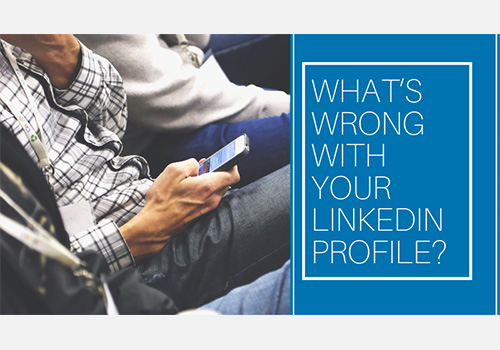
According to a recent study, 87% of recruiters out there use LinkedIn as a vetting source to narrow down the list of potential candidates they’re willing to consider during the hiring process.
The truth is this: If your profile isn’t painting a picture of what you’re about and how well you can get the job done, you could very well be missing out on the next best thing, without even knowing it.
Although there are no hard and fast guarantees that you’ll get hired if you follow this advice, there are a few things your LinkedIn profile has to contain in order to up the odds that you’ll get noticed by recruiters out there. Here’s what will make recruiters reach out or recoil…
An Incomplete Profile
Recruiters want to see your work experience, accomplishments, and your education featured on your LinkedIn profile. Having an incomplete profile can make it harder for them to determine whether or not you’re a match for the position they’re trying to fill.
Selfies
As with all social media accounts, a profile picture definitely makes the first impression, which is exactly why you need to put a little effort into it. Your profile picture should resemble something professional and be representative of the job market you’re in. the only thing a selfie or a picture of you on the beach will tell a recruiter is the fact that you’re not concerned about making yourself look more professional.
Discrepancies
In order to confirm information about a potential candidate, recruiters often consult the person in question’s LinkedIn profile. You have to ensure that your dates of employment and other facts such as job titles correspond with the information you’ve provided on your resume. This will ensure that the recruiter understands that you are detail-oriented, and not being untruthful on either your resume or social media profile.
Powerful Summaries
Your LinkedIn profile summary should highlight you in a way that makes sense to recruiters. It should tell a short but concise story about your educational background as well as your professional achievements. Recruiters love seeing short copy blocks and bullet points, which makes reading the summary easy and effortless.
A Great Headline
A lot of recruiters find LinkedIn profiles with the help of search engines such as Google. This means that the results they get from the result page will often include your location and a professional headline that appears under your name in your profile. This matters a whole lot more than you give it credit for, so make sure your headline clarifies your industry and job function.
Jargons and Inflated Job Titles
To yourself, you may feel like “The Supreme Conveyor of IT Knowledge”, but to a recruiter, it’s a waste of time and means they’ll have to guess what your real job title is. The same can be said for candidates that promote themselves as VPs of their departments with a mere 2 years of experience. You don’t want to appear disingenuous or untrustworthy, so just stick to using genuine job titles for your profile.
Inappropriate Language
Using profanity or suggestive language on your LinkedIn profile is never a good idea, whether it’s your own thoughts, articles you’ve shared, and statuses you’ve liked. You want and need a recruiter to see you as professional, so don’t do things online which can have the opposite results.
The Wrap Up
In order to position yourself as a good match for a potential position, you’ve got to keep an eye out of anything on your LinkedIn profile that could be perceived in a negative light and take you out of the running for a specific role. A well put-together LinkedIn page could dramatically improve the likelihood that you’ll pique recruiters’ interest, which could, in turn, help you land that next great gig!


